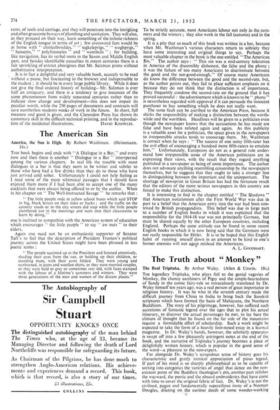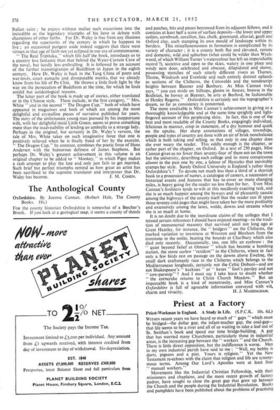The Truth about Monkey"
The Real Tripitaka. By Arthur Waley. (Allen & Unwin. 18s.)
THE legendary Tripitaka, who plays foil to the genial vagaries of Monkey, the clumsy earthiness of Pigsy and the simple-heartedness of Sandy in the comic fairy-tale so miraculously translated by Dr. Waley himself ten years ago, was a real person of great importance in religious history. It was he who in the seventh century made the difficult journey from China to India to bring back the Sanskrit scriptures which have formed the basis of Mahayana, the Northern Buddhism.- The story of his pilgrimage, however, has suffered such accretions of fantastic legend over the ages that to plot his actual itinerary, to discover the actual personages he met, to lay bare the climate of thought that he found on the far side of the mountains require a formidable, effort of scholarship. Such a work might be expected to take the form of a heavily foot-noted essay in a learned magazine. In Dr. Waley's hands, however, the scholarly apparatus is swept off into a few pleasantly astringent notes at the end of the book, and the narrative of Tripitaka's journey becomes a piece of delightfully written history, which is popular in the good sense of the word—a pleasure to the non-expert.
For alongside Dr. Waley's scrupulous sense of history goes his characteristic and gently ironical appreciation of pious legend. If part of his mind is so sharply philosophical as to be capable of sorting into categories the varieties of angel that dance on the non- existent point of the Buddhist theologian's pin, another part relishes the wayward, the poetic and the absurd embroideries that have come with time to cover the original fabric of fact. Dr. Waley's is not the civilised, pagan and fundamentally supercilious irony of a-Norman Douglas, dilating on the curious deeds of some wonder-working Italian saint ; he enjoys without malice such excursions into the incredible as the legendary triumphs of his hero in debate with champions of other faiths. For Dr. Waley is free from any illusions regarding the superiority of the century in which he happens to live ; an occasional pungent aside indeed suggests that there were virtues in that age of faith not yet eclipsed in our era of commonsense.
" The Real Tripitaka," which fills half the book, introduces us to a country less fantastic than that behind the Water-Curtain Cave of the novel, but hardly less enthralling. It is followed by an account of the further transmigration of Buddhism to Japan in the eighth century. Here Dr. Waley is back in the Tang China of poets and war-lords, court eunuchs and disreputable monks, that we already know from his life of Po Chili. He throws a little fresh light by the way on the persecution of Buddhism at the time, for which he finds sordid but unideological reasons.
The latter part of the book is made up of stories, either translated or in the Chinese style. These include, in the first category, " Mrs. White " and in the second " The Dragon Cup," both of which have appeared in magazines and both of which are among the most delightful and crystalline pieces of narrative published for years. The story of the unfortunate young man pursued by his inopportune wife, with her delightful maid Little Green, seems to prove something more than the inadvisability of lending an umbrella to a strange lady. Perhaps in the original, but certainly in Dr. Waley's version, the tale of Mrs. White takes on such imaginative force that one is positively relieved when he is finally freed of her by the exorcist. " The Dragon Cup," by contrast, combines the poetic force of Hans Andersen with the humorous deftness of James Stephens. But perhaps Dr. Waley's greatest achievement in this volume is an original chapter to be added to " Monkey," in which Pigsy makes a rash attempt to play the lute and only just fails to get married. Such brief but perfect triumphs remind us how great an artist has been sacrificed to the supreme translator and interpreter that Dr.



































 Previous page
Previous page